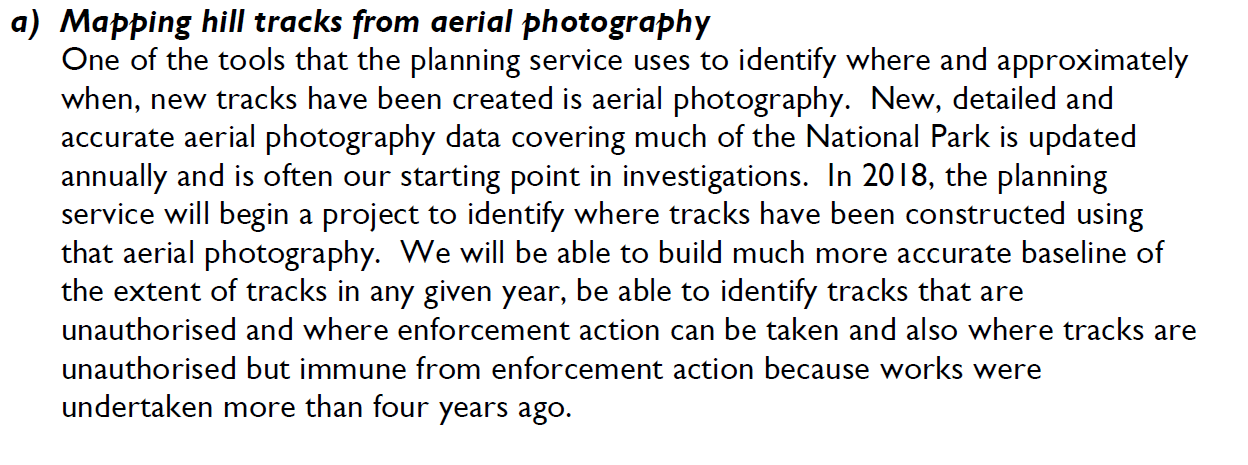
For the last 18 months parkswatchscotland has been highlighting the failures of both our National Parks to protect the landscape and more specifically to ensure that planning conditions are enforced. On Friday the Cairngorms National Park Planning Committee, on which all Board Members sit, approved a plan to address the issues. Its extremely welcome and while I’d recommend all who care about our landscapes read it in its entirety (see here) this post will explain why I believe its such a major step forward and indicate some of the challenges ahead.
The paper starts from a position of honesty and many of the cases highlighted on Parkswatch are mentioned in the report, from the unlawful creation of hill tracks at Cairngorm, Dinnet and Cluny to the destruction caused by work on the hydro schemes at Bruar and Corriemulzie. Other examples – yet to be featured on parkswatch! are also mentioned and the paper ends by referring to “breaches that could have been avoided”. That is an honest assessment of the situation and combined with a clear view of the role of enforcement “a discretionary function but one that is important to confidence in the planning system” provides a sound framework for action.
I was pleased that the actions are not just about enforcement and that the paper considered why things to wrong:

and preventive solutions:

I would have gone further than this, believing that we will never have effective monitoring of schemes in remote areas unless that monitoring is undertaken by a truly independent person, rather than an Ecological Clerk of Works paid for and therefore in hock to the Developer. I would also like to see more detailed specifications for hill track design and ground restoration but this could still be included in the proposal to tightening the wording of conditions imposed on developments. What officers have been doing however is a major step forward.
Three major new changes were announced/approved to make enforcement more effective and have driven due to concerns about the proliferation of unauthorised hill tracks in the Cairngorms. The first is that in order to take enforcement action against such tracks the CNPA needs to know where existing tracks are and is basically setting up a track register:

It may be almost 30 years since the former Kincardine and Deeside Council mapped hill tracks in their area but that the CNPA has now picked up that mantle again is extremely welcome.
More innovative, is the proposal to make it much easier for hill goers to report tracks:

Encouraging involvement from the recreational community – and others who go on the hill – in this way is extremely welcome. Apart from slight tensions when reporting the destruction of the Shieling Hill Track at Cairngorm, I have to say that for every other track I have reported, I have always had a positive response from staff at the CNPA. Many of those cases I understand are included in the further 12 hill track cases, involving 40k of track, where the CNPA is now taking enforcement action. There is no need to wait until the online facility is created, you can send reports and photos to planning@caingorms.co.uk.
The third element of the proposals is to delegate enforcement powers from the Committee to officers. While I have expressed many concerns about the way the Loch Lomond and Trossachs National Park Authority have delegated decisions to officers – far more than in the CNPA and its been a disaster – in terms of practical enforcement actions, time is of the essence and enforcement should not wait for weeks until it can be considered by committee. I therefore believe the proposals to devolve to officers the ability to issue notices about planning contraventions, breach of conditions, requiring developers to apply for planning permission (section 33) and to stop works is absolutely right. My only concern is that the temporary stop notice is described as a last resort when actually, in cases where a developer does not immediately stop unlawful works voluntarily, it should be the notice of first resort.
In summary, the CNPA has now given itself the tools it needs to ensure developers respect the planning system in the National Park far more than they have up to now. The big challenge now is to implement this and ensure it happens. How big a challenge that is is demonstrated by the CNPA’s planning enforcement register a link to which is provided in the report. The last entry is for 2016:

So, making enforcement happen, through the Courts if necessary, remains a major challenge.
In terms of other next steps, the CNPA has stated that the issue of hill tracks on open moorland is one it would like to tackle in the Main Issues report for the new Development Plan and is inviting public support for this which is welcome. I believe though it also needs to strengthen the messages it is giving to landowners NOW and rather than admonishing them for breaches of planning conditions starts warning them of the consequences of the failure to comply with the planning system. Sending every landowner and every land agent/factor who operates in the National Park a copy of the Enforcement Report with a covering letter warning them what action the CNPA will take against breaches of planning condition/unauthorised developments in future would be a good start.
If landowners and land agents believe the National Park is serious about enforcement action, then failure to abide by the planning system will become a financial liability with cost implications which will also affect the value of their land. The CNPA only need to demonstrate they will pursue a couple of enforcement cases to the bitter end and I believe every landowner in the National Park would start to take the planning system more seriously.

An independently appointed (by the Park Authority) Planning Monitoring Officer to check planning compliance on the ground would be useful in ensuring effective Planning Control. I do say this as a PMO employed to monitor many schemes across Scotland for a range of Local Authorities.
When things actually get built is the crunch point, its where the theoretical development proposals (as outlined in the Environmental Statement) hit the reality on the ground, and with the best will in the world things always change. You can try to write tight Planning Conditions, and the Developer can do as much Site Investigation as possible but things change. The best way of monitoring compliance and facilitating change is eyes on the ground via regular site visits.
Some Local Authorities finance a PMO from Developer contributions but appoint the PMO themselves. Its a way of dealing with the massive workloads most Enforcement Officers face and its usually limited to large developments, or smaller developments but located in sensitive locations.
This is very interesting – out of interest do you know if our NPs have ever engaged independent Planning Monitoring Officers?